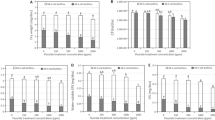Abstract.
With human saliva as an inoculum, microcosm dental plaques were grown on dental amalgam in a constant-depth film fermentor (CDFF) in the presence (suc +ve) and absence (suc −ve) of sucrose. The biofilms were then exposed to 0.2% chlorhexidine gluconate (CHG) for 1, 5, or 60 min and the survivors enumerated. Suc +ve biofilms had higher proportions of streptococci but lower proportions of veillonellae than suc −ve biofilms. Exposure to CHG for 1 min reduced the viable count of suc −ve and suc +ve biofilms by 53% and 89% respectively. In both cases, reductions were mainly attributable to killing of streptococci and actinomyces. After 60 min of exposure, 4% of the bacteria in the suc −ve and 2% in the suc +ve biofilms remained viable. This study has shown that large numbers of bacteria in microcosm dental plaques can survive a 1-min exposure to 0.2% CHG and that even after a 60-min exposure, substantial numbers of bacteria remain viable.
Similar content being viewed by others
Author information
Authors and Affiliations
Additional information
Received: 16 May 1997 / Accepted: 7 July 1997
Rights and permissions
About this article
Cite this article
Wilson, M., Patel, H. & Noar, J. Effect of Chlorhexidine on Multi-Species Biofilms. Curr Microbiol 36, 13–18 (1998). https://doi.org/10.1007/s002849900272
Issue Date:
DOI: https://doi.org/10.1007/s002849900272




